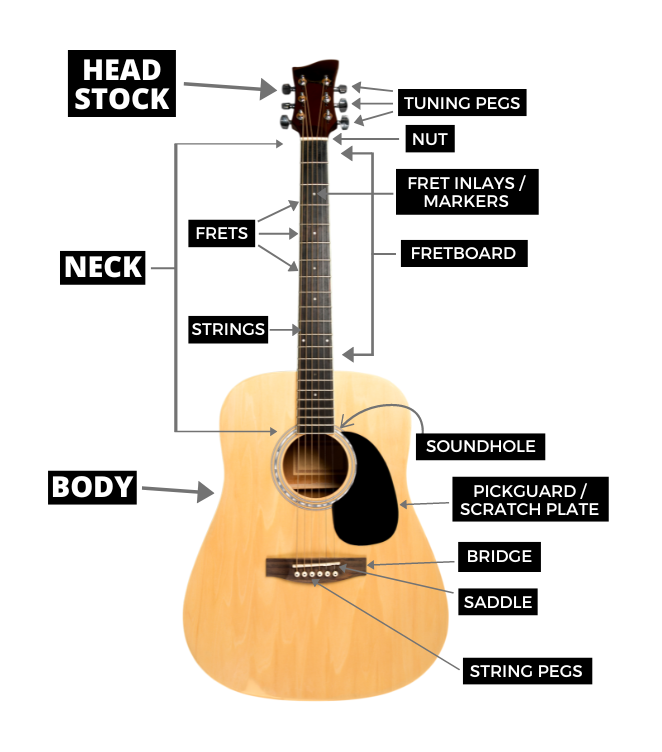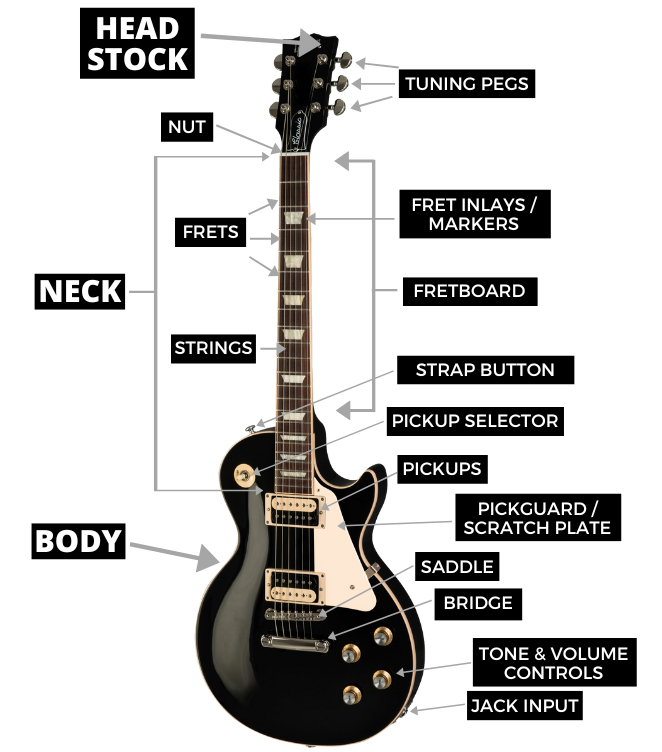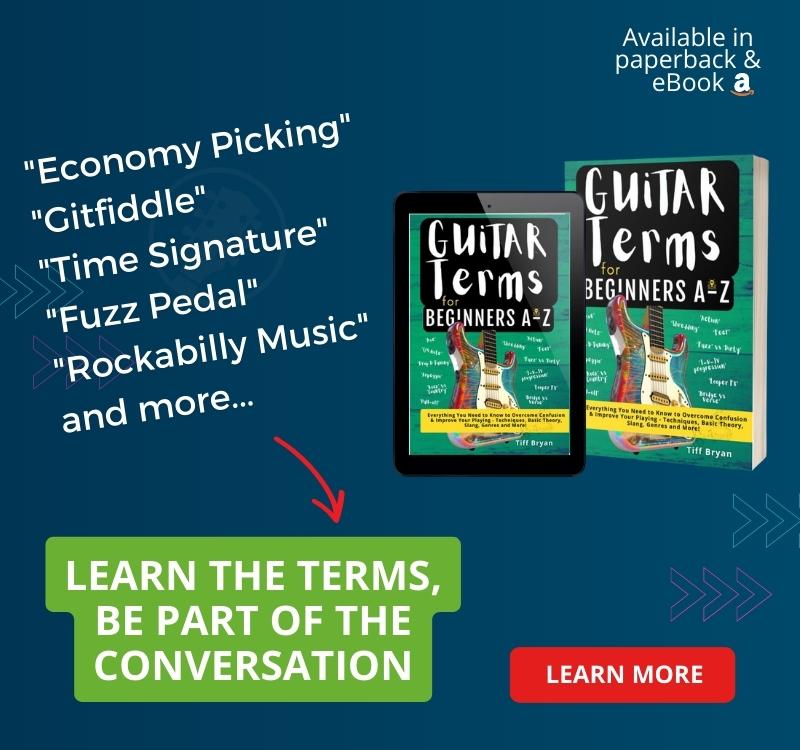Don’t stay stuck in the guitarist newbie trap – learn the guitar terms and language you NEED to know and avoid confusion.
Have you ever come across guitar-related terms that left you scratching your head in confusion?
From “economy picking” to “rhythm guitar” and “passing tone,” the world of guitar playing is filled with unique terminology that can be daunting for beginners and experienced guitar players equally.
But fear not! In this extract from the comprehensive book Guitar Terms for Beginners A-Z, we’ll explore some essential guitar terms and provide examples from each book section to help you quickly grasp the need-to-know words.
What are some of the parts of a guitar called?
Body:
(From Part 1: Parts of a Guitar) The body on a guitar is the largest part of the instrument that includes the top (aka sound board), back, sides, and sound hole.
The body shape and size of a guitar can vary depending on the guitar’s style and tonal qualities. The wood used in the body affects the acoustic guitar’s tone and resonance. (Bold terms found in the book.)
Bridge:
(From Part 1: Parts of a Guitar) The bridge on a guitar is the piece that anchors the strings to the body and transmits the strings’ vibrations to the sound board, which is the large wooden panel on the front face of the acoustic guitar. (Bold terms found in the book.)
Fret Inlays / Markers:
(From Part 1: Parts of a Guitar) Fret inlays are the small dots on the fretboard of a guitar or stringed instrument that help players navigate the instrument and keep track of their hand positions.
Fret inlays also add a decorative feature to a guitar. (Bold terms found in the book.)
Fretboard:
(From Part 1: Parts of a Guitar) Also known as the ‘fingerboard’, the fretboard is attached to the guitar neck and it’s where you press down on the strings to produce different notes.
The wood used for the fretboard can affect the resonance and sustain of the notes produced. (Bold terms found in the book.)
Frets:
(From Part 1: Parts of a Guitar) Guitar frets are the thin metal strips embedded in the fretboard that serve two main functions. First, they divide the neck into intervals that allow the guitarist to find and play particular notes.
Second, they raise the string off the fretboard, allowing the player to change its length and, therefore, the note’s pitch. (Bold terms found in the book.)
Headstock:
(From Part 1: Parts of a Guitar) The headstock is the top section of the guitar neck where the tuning pegs (aka machine heads) and strings are attached. It helps to hold the strings in place and allows you to tune each string to the desired pitch. (Bold terms found in the book.)
Pickguard (aka Scratch Plate):
(From Part 1: Parts of a Guitar) A pickguard on a guitar is a protective plate on the guitar’s body, underneath the sound hole, that helps to prevent scratches and dings from a plectrum (aka guitar pick) or fingers. (Bold terms found in the book.)
Saddle:
(From Part 1: Parts of a Guitar) A guitar saddle is a small piece of plastic, bone, or other material that sits in the guitar’s bridge and provides a contact point for the guitar strings. (Bold terms found in the book.)
String Pegs:
(From Part 1: Parts of a Guitar) On a guitar, the string pegs are the small cylindrical pieces on the bridge of an acoustic guitar that help to keep the strings anchored in place. (Bold terms found in the book.)
Strings:
(From Part 1: Parts of a Guitar) Guitar strings are metal or nylon wires that run along the length of the guitar neck and produce sound via vibration when strummed or plucked.
Acoustic guitar strings are usually thicker than electric guitar strings, and the different material types include bronze, phosphor bronze, silk and steel.
Tuning Pegs (aka Machine Heads)
(From Part 1: Parts of a Guitar) Tuning pegs are the geared pegs at the headstock of a guitar used to adjust the tension of the strings, which in turn changes the pitch of the notes produced by the guitar. By turning the tuning pegs, you can either loosen or tighten individual strings to achieve the desired pitch. (Bold terms found in the book.)
Sound Hole:
(From Part 1: Parts of a Guitar) A sound hole is the circular hole on the guitar body that lets the sound of the vibrating strings resonate inside the hollow chamber and project outwards. The sound hole plays a role in determining the tone and volume of the guitar. (Bold terms found in the book.)
Parts of an Acoustic Guitar
Parts of an Electric Guitar
What is the difference between single-coil and humbucker pickups?
Humbucker Pickup:
(From Part 1.1: Additional Guitar Parts Terms) A humbucker pickup is a type of pickup (an electric sound converter) with two magnetic coils that cancel out the hum and noise of a guitar signal.
Known for its warm and thick sound, the Gibson Les Paul is a famous guitar with two humbucker pickups. Examples of iconic humbucker-loving guitarists include Black Sabbath’s Tony Iommi and Slash from the band Guns ‘n’ Roses. (Bold terms found in the book.)
Single-Coil Pickup:
(From Part 1.1: Additional Guitar Parts Terms) A single-coil pickup is a type of pickup (an electric sound converter) known for its bright and clear sound. It has a single magnetic coil that picks up the strings’ vibrations and sends them to an amplifier.
Single-coil pickups are associated with makes like Fender Stratocaster guitars, popularised by guitar legends such as Jimi Hendrix and John Mayer. (Bold terms found in the book.)
What is a truss rod?
(From Part 1.1: Additional Guitar Parts Terms) A truss rod is a metal bar that runs the length of a guitar neck from the nut to where the neck joins the body. The job of the truss rod is to help balance the effect of string tension on the neck via adjustments to the guitar’s neck relief. (Bold terms found in the book.)
What is an arpeggio?
(From Part 2: Guitar Terms Glossary) An arpeggio is a technique where a chord is played one note at a time rather than being strummed or plucked simultaneously. Arpeggios typically involve playing each chord note in sequence, usually in an ascending and descending pattern.
They can help to elevate even the simplest chord progression, add variation to melodies and solos, and sharpen your picking accuracy tenfold. (Bold terms found in the book.)
What is fingerstyle guitar?
(From Part 2: Guitar Terms Glossary) Fingerstyle guitar is a style of guitar playing where the guitarist plays the guitar by plucking the strings with the fingertips and thumb or with picks attached to the fingers.
You can play fingerstyle on any type of guitar, but the style is mainly associated with acoustic, classical and flamenco guitars. (Bold terms found in the book.)
What does fretting mean?
(From Part 2: Guitar Terms Glossary) The term “fretting” means when you press down on the strings of an instrument, such as a guitar, ukulele, or mandolin, with your fingers to play notes and chord shapes.
The left hand is the fretting hand for right-handed players, and the right hand is the fretting hand for lefties.
What are Harmonics?
(From Part 2: Guitar Terms Glossary) On the guitar, harmonics are sound waves (notes) whose frequencies are whole number multiples of a primary note frequency, called a fundamental.
For example, the top E string on a guitar has a fundamental frequency of 82.4Hz; the next harmonic is, therefore, 164.8Hz (82.4 x 2). (Bold terms found in the book.)
What are TABs / Tablature?
(From Part 2: Guitar Terms Glossary) Tablature is a guitar-specific form of music notation with numbers and symbols that help guitar players learn songs and techniques.
Commonly known as ‘TAB’, it shows the placement of fingers on a guitar’s fretboard rather than the traditional staff notation used in sheet music. (Bold terms found in the book.)
What is vibrato on the guitar?
(From Part 2: Guitar Terms Glossary) Vibrato is a technique used mainly in lead guitar playing, where you press a finger on a string and play multiple bends to alter the note’s pitch.
Vibrato is an expressive technique guitarists of all styles use to add dimension and spirit to their playing. Using a tremolo arm or vibrato effects pedal also recreates a vibrato effect. (Bold terms found in the book.)
What is guitar distortion?
(From Part 3: Slang for Guitar Sounds) Guitar distortion is the deliberate alteration of a guitar’s sound to create a distorted, rough, or edgy tone. This effect is achieved by intentionally overloading the amplifier or using a distortion pedal.
Distortion is a key element in rock, metal, alternative, and experimental music. It creates diverse tones that range from aggressive and powerful to lo-fi and gritty. (Bold terms found in the book.)
What is a lick?
(From Part 3: General Guitar Slang Terms) A guitar lick is a quick musical phrase played on the guitar that adds flair to a tune. A lick is similar to a riff and can also be thoughts of as a mini slice of a guitar solo.
Licks are also a way to practise your chops and show off your guitar playing skills. (Bold terms found in the book.)
What is a capo?
(From Part 4: Guitar Accessories Terms) A capo is a device that changes the pitch of guitar notes by clamping onto the fretboard. It makes it easier to play pieces in various keys and tunings.
Because some songs require a capo to match the original recording that used one, a capo is a top accessory to have. (Bold terms found in the book.)
What is an effects pedal / Guitar FX?
(From Part 4: Guitar Accessories Terms) An effects pedal is an electronic device that changes the sound of an audio source, such as a guitar, by altering the incoming signal to produce specific effects.
Effects pedals are powered by digital or analogue circuitry, and they’re also called ‘stomp boxes’ and ‘FX pedals’. Popular guitar effects pedals include delay effects pedals, looper pedals, and vibrato pedals. (Bold terms found in the book.)
Summing it up
In this article, we’ve explored fascinating excerpts from the book Guitar Terms for Beginners A-Z. This comprehensive guide is a valuable resource for any guitarist, packed with information on all aspects of guitar playing, from the basics to more advanced techniques.
To take your playing to the next level, order your copy today here.










